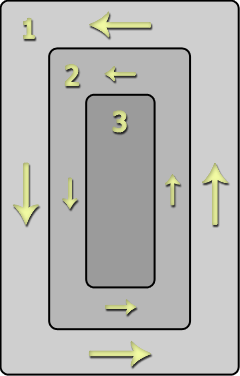Dance etiquette is a set of guidelines that help us navigate the social dimensions of dancing.
Floorcraft
Many ballroom dances MOVE around the floor. To enable safe dancing, dancers should follow the line of dance: the counter-clockwise direction of dance around the dance floor. The diagram on the right indicates the rules for the dance floor. By following this convention, all the different dancing skill levels can enjoy dancing on the floor at the same time.
When not dancing, move well away from the dance traffic.
1 - Outside lane: for couples comfortable with the dance style and tempo. Do not stop or dance across the flow of traffic. Be aware of other dancers to avoid collisions! Dances which progress around the line of dance are Waltz, Tango, Foxtrot, Samba, Viennese Waltz, Quickstep, Two Step and Polka.
2 - Inner lane: for couples praticing new steps or executing steps performed in counter direction. Forward movement is the line of dance.
3 - Floor center: for couples dancing in place or who need to stop from time to time while practicing new steps. In place dances and steps include Cha-cha, Rumba, Jitterbug, Lindy Hop, Salsa, slow dancing, free style, West Coast Swing, spot turns, fleckerels, position or dance poses. Please do not execute in-place steps in the outside lane.
|
 |